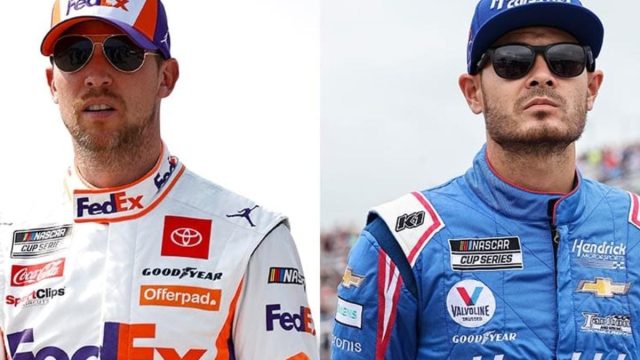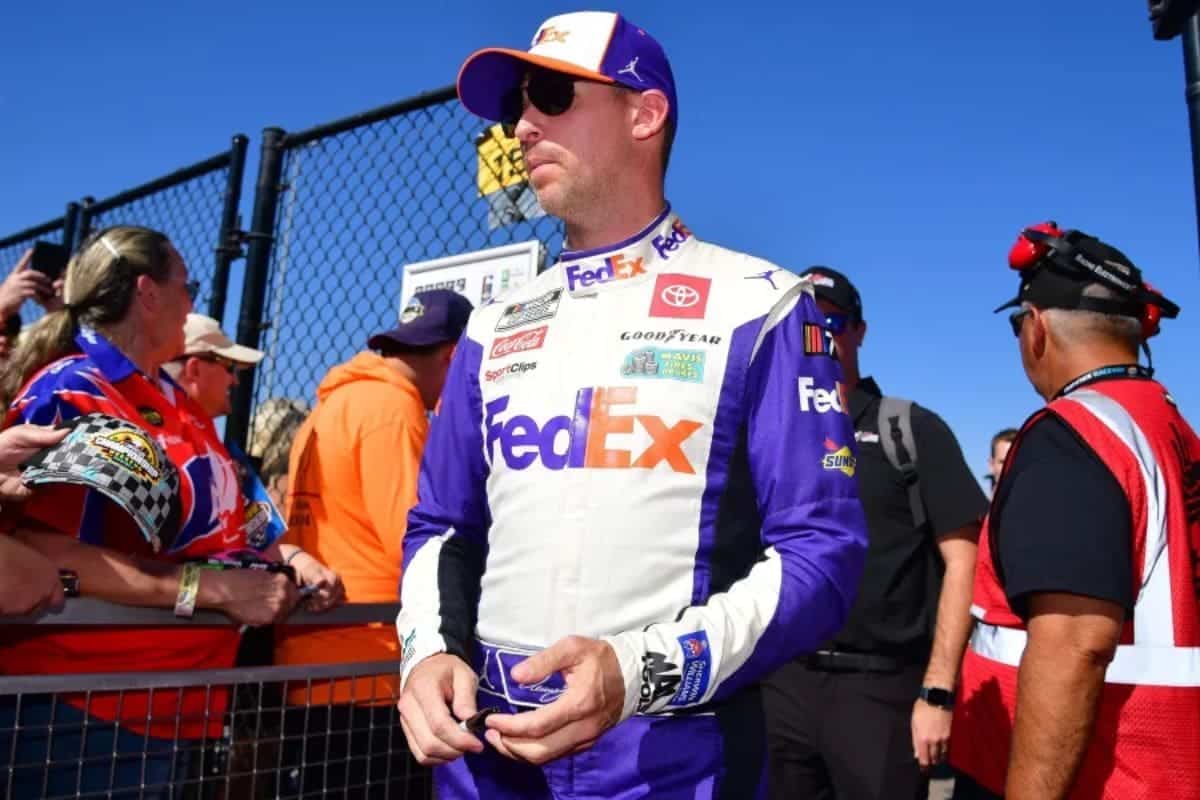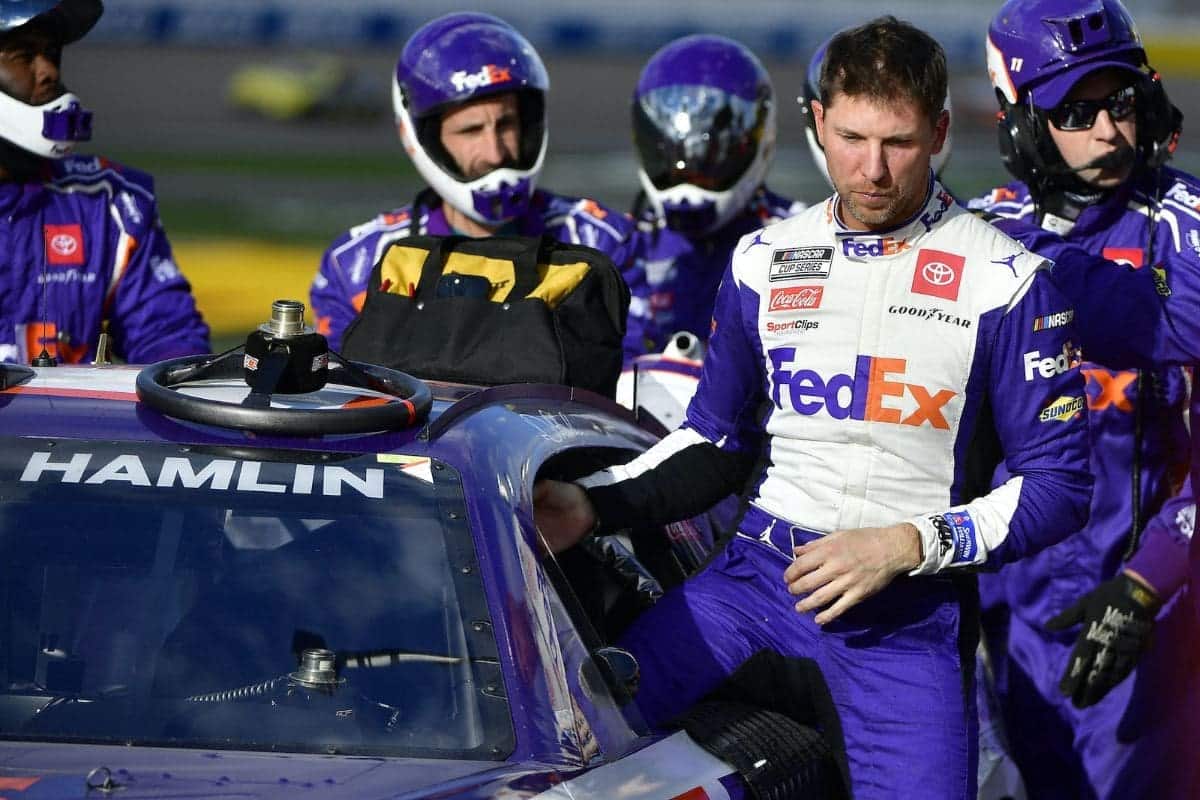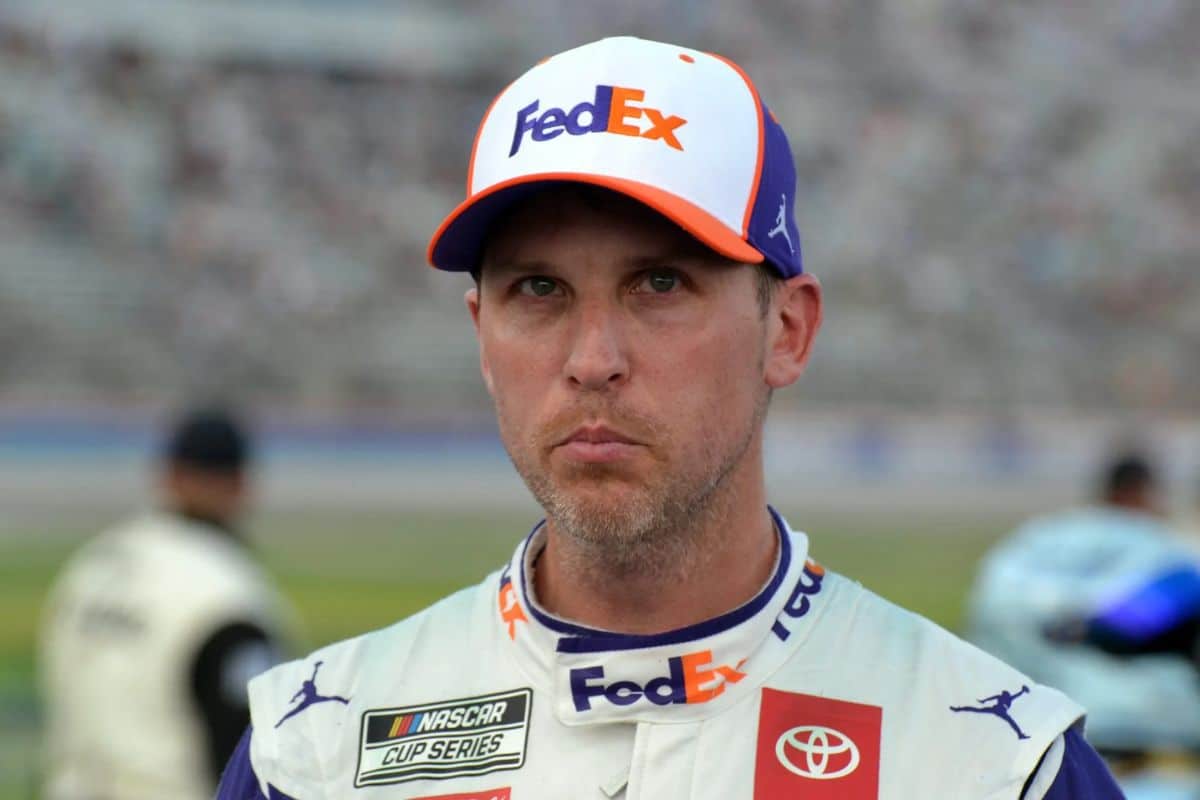Denny Hamlin Admits Iowa Mistake: Denny Hamlin‘s recent acknowledgment of his mistake during the Iowa Corn 350, despite receiving backing from Kyle Larson, highlights a significant moment of openness in the high-pressure world of NASCAR. This open admission not only reflects Hamlin’s commitment to personal growth and accountability but also draws attention to the underlying dynamics of driver relationships and on-track strategy. As the incident involving Daniel Suarez played a pivotal role in the race’s outcome, the consequences of Hamlin’s error and Larson’s supporting stance offer intriguing insights into the complexities of competitive racing.
Key Highlights
- Denny Hamlin admitted a strategic error during the Iowa race, leading to a disappointing finish.
- Hamlin took full responsibility for the misjudgment and emphasized learning from the mistake.
- Kyle Larson provided support to Hamlin, showcasing camaraderie and sportsmanship.
- The incident highlighted the need for better decision-making and strategic planning in racing.
- Hamlin stressed the importance of self-reflection and accountability for future improvement.
Initial Race Dynamics and Rivalry at Iowa Corn 350
The Iowa Corn 350 began with a core interplay of strategic tactics and growing rivalries, prominently featuring Kyle Larson and Denny Hamlin. From the start, the race dynamics suggested a tight contest, initially implying a primary duel between Larson and Ryan Blaney. However, the race narrative quickly evolved as Josh Berry and Chris Buescher intermittently took the lead, showcasing the unpredictable nature of short-track racing.
Kyle Larson, a formidable contender with a history of strong performances, maintained a strategic approach, adapting his tactics to respond to the shifting leader board. While Larson’s adaptability on the track was evident, Hamlin’s experience and tactical skills could not be overlooked. Despite not breaking into the top five, Hamlin’s presence was felt, particularly as he engaged with Larson, adding complexity to the competition.
Joe Gibbs Racing’s Denny Hamlin, although struggling to secure a top-tier position, managed to stir the race. His interactions with Larson were marked by a blend of strategic aggression and defensive driving, indicative of their ongoing rivalry. Hamlin’s attempts to disrupt Larson’s rhythm were transparent, yet Larson’s resilience and tactical counter-moves highlighted his skill.
On-Track Incident and Post-Race Reactions
An incident on the track involving Denny Hamlin and Kyle Larson dramatically altered the course of the Iowa Corn 350, ultimately removing both of them from the competition and reshaping post-race discussions. The collision occurred during a critical point of the race, dashing the hopes of both contenders for a victory. The aftermath of this wreck, however, offered a detailed narrative that extended beyond the confines of rivalry and competition.
Denny Hamlin struggled right from the start at Iowa Speedway. Despite winning two short-track races earlier this year, he dropped positions rapidly within the first five laps. At one point, Hamlin was running outside the top 20 and even dipped as low as 30th place. However, after lap 150, Hamlin made a strong comeback, breaking into the top ten. Then, on lap 172, he made contact with Larson’s No. 5 car in turn 2, leading to strong reactions from his rival.
Initially, Kyle Larson’s frustration was evident as he reacted to Hamlin’s contact, which had precipitated the accident. His immediate response highlighted the tension that often accompanies high-stakes racing. Nevertheless, Larson’s post-race demeanor demonstrated a commendable shift. He softened his stance, opting for a more measured and understanding perspective.
Denny Hamlin’s reaction to the incident also showed a significant evolution. Earlier in his career in 2023 at Pocona, Hamlin might have been more inclined to deflect blame or deny culpability. However, in this instance, he openly acknowledged his mistake, an admission that adds a layer of depth to his character and professional growth. By taking responsibility, Hamlin not only diffused potential hostility but also contributed to a more constructive post-race dialogue.
“Yeah, we lapped him. I don’t know, he got…slightly got into the back of me, and got me at the racetrack. So I doubt it was intentional. I wouldn’t see why it would be intentional. Yeah, I was just frustrated but we’ve gone fine.” – (hamlin)
“It was my mistake. I gassed up too soon and ran him back up.” – (hamlin)
Impact of Daniel Suarez’s Involvement
Daniel Suarez’s involvement in the incident, particularly his contact with Kyle Larson around lap 220, dramatically altered the dynamics of the Iowa Corn 350. Suarez’s move initiated a chain reaction when his vehicle clipped Larson’s left side and spun him, resulting in the No. 5 Chevy smashing into the outer wall. This collision not only compromised Larson’s race but also involved Denny Hamlin’s No. 11 Toyota, effectively eliminating two major contenders from the competition.
Analyzing Suarez’s role, it becomes evident that his actions were a crucial turning point. Prior to the incident, both Larson and Hamlin were positioned strategically, with Larson leading for a significant portion of the race. Suarez’s contact disrupted their momentum, introducing a new variable that neither team had anticipated.
Furthermore, the incident spotlighted Suarez’s aggressive racing style, which has been criticized and praised in different contexts. While some may argue that such tactics are part of the sport’s competitive nature, others believe that Suarez’s approach in this instance was reckless, threatening not only his own race but also those of his peers.
Kyle Larson’s Dominance and Frustration
Kyle Larson exhibited remarkable dominance in the Iowa Corn 350, leading for 80 laps and capturing victory in stage 2, only to see his efforts unraveled by an untimely wreck in the final stage. His performance demonstrated not only his skill but also his strategic intelligence, managing to stay ahead of the competition for a substantial portion of the race. Larson’s ability to control the pace and maintain his lead was a confirmation of his driving expertise and the effectiveness of his team’s preparation.
However, the race took a dramatic turn in the final stage when an incident involving Daniel Suarez led to a wreck that greatly impacted Larson’s position. Despite Larson’s earlier success and dominance, the wreck was a critical point that ultimately relegated him to a 34th-place finish and Blaney secured a top-10 finish.
Kyle Larson said he didn't think the contact from Denny Hamlin when Hamlin got into the back of him and pushed him up the track was intentional. Hamlin said it wasn't. What they said about it after Iowa: pic.twitter.com/iZEz7SZCKr
— Bob Pockrass (@bobpockrass) June 17, 2024
Larson’s frustration was noticeable post-race, as the wreck not only cost him a potential win but also valuable points in the championship standings. His reaction emphasizes the fine margins that can define a race’s outcome and the emotional toll such incidents can take on drivers. Despite the setback, Larson’s display of skill up until the wreck remains impressive, showing his potential and resilience as a top contender in the series.
Reflections and Future Prospects
Reflecting on the turbulent outcome of the Iowa Corn 350, Larson acknowledged the complexities of the race and the lessons it imparted, while expressing cautious optimism for his upcoming challenges. The incident, which saw a collision with Daniel Suarez, displayed the unpredictable nature of racing and emphasized the need for adaptability and strategic foresight.
“If I could see a replay, I would tell you what went wrong, if it was my fault or what. I mean, obviously, if I don’t go three-wide there, there’s probably no crash but I’m probably running sixth into Turn 1 so, but either way sixth is better than a crash.” – (larson)
Larson’s reflections reveal a multifaceted understanding of the event and its implications for his future endeavors. He took responsibility for part of the mishap, demonstrating a commendable level of accountability. However, he did not shy away from criticizing Suarez’s aggressive actions, which he deemed excessive and counterproductive. This balanced perspective highlights Larson’s ability to critically assess his actions and those of his competitors.
“Like I said, I think just, I should have been more aware of who I was around. Suárez is really aggressive, and I don’t know. He was probably just pushing and got loose, I’m guessing, underneath me.” – (larson)
- Strategic Planning: Enhancing race strategies to anticipate and mitigate risks posed by aggressive competitors.
- Communication: Improving in-race communication with his team to make real-time adjustments.
- Technical Adjustments: Fine-tuning the car setup to better handle diverse track conditions.
- Mental Resilience: Strengthening mental fortitude to maintain focus and composure under strain.
News in Brief: Denny Hamlin Admits Iowa Mistake
Hamlin’s acknowledgment of his error at the Iowa Corn 350, despite Larson’s support, highlights the crucial role of accountability in NASCAR. This incident emphasizes the intricate dynamics of racing, where split-second decisions can greatly impact outcomes.
The involvement of Daniel Suarez adds complexity to the race’s narrative. Hamlin’s reflection on his misjudgment emphasizes the sport’s demand for continual self-improvement and the underlying solidarity among drivers, fostering resilience and growth within the competitive racing environment.
ALSO READ: Denny Hamlin Faces Goodyear’s Early Impact at Iowa Race Night



